Posts Tagged ‘Buddha’
Gandhara Sculpture – the first anthropomorphic images of Buddha
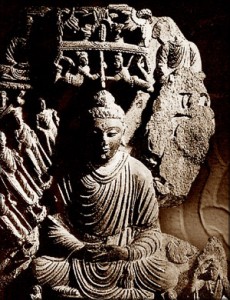 This is the most complete collection in India, which can compete according to its content only with the collection of the Museum of Lahore in Pakistan.
This is the most complete collection in India, which can compete according to its content only with the collection of the Museum of Lahore in Pakistan.
The north-western region of India and part of what is now called Pakistan and Afghanistan in the first century AD were known as Gandhara. In the era of the conquests of Alexander the Great, the area experienced the Greek influence, and later, with the strengthening of trade relations with the Roman Empire, the influence of the Romans. On the territory of Gandhara appeared numerous princedoms and great cities which flourished thanks to the trade development.
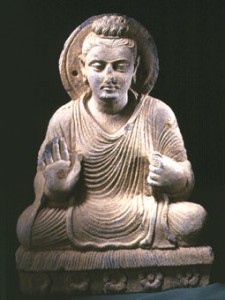 The famous Buddhist university at that time, Taxila, attracted the Buddhist scholars from China and other countries of the Far East, as well as from Asia. Excavations in Taxila and adjacent areas opened to our eyes the splendor stupas, statues, coins and other valuables, each of which bears a greater or lesser degree of Roman or Greek influence.
The famous Buddhist university at that time, Taxila, attracted the Buddhist scholars from China and other countries of the Far East, as well as from Asia. Excavations in Taxila and adjacent areas opened to our eyes the splendor stupas, statues, coins and other valuables, each of which bears a greater or lesser degree of Roman or Greek influence.
Over the past few years among art historians has spread many conflicting opinions about the question of whether the first anthropomorphic images of Buddha were the result of Greco-Roman influence. To date, studies have shown that the Buddha statues appeared in different regions of India at about the same time with the sculpture of Gandhara.
Statues of wood, terracotta, stone and even metal were created by Indian artists for centuries, and it was not their first attempt at figurative sculpture. But what is truly interesting in the period of the masters of Mahayana Buddhism, is the embodiment of the Buddha, which can transmit the power and clarity of the mind in meditation.
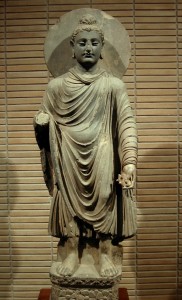
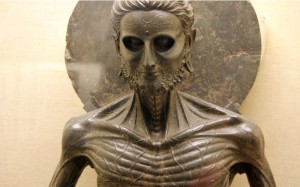 Early sculptures suggest that the artist had a lot to experiment with facial expressions, attire and postures of the Buddha, whose face is sometimes smiling. Some of the statues in the gallery have been transferred to the Museum by General Cunningham, they belong to the period of Mahayana Buddhism, when it became possible to depict the Buddha in human form. Here there are also some votive stupas, donated by devotees to the holy shrine. With these votive stupas, many of which are signed, the historians have had the opportunity to create a more clear idea about the patrons of Buddhism. It was found that a large number of traders have so many followers of the new religion of the time, and their wealth has contributed to its development and penetration into other parts of Asia. Since there were stupas near trade routes, semicircular Indian stupa began to increase in height until it took the form of a high towers, some of which can still be seen in the Far East.
Early sculptures suggest that the artist had a lot to experiment with facial expressions, attire and postures of the Buddha, whose face is sometimes smiling. Some of the statues in the gallery have been transferred to the Museum by General Cunningham, they belong to the period of Mahayana Buddhism, when it became possible to depict the Buddha in human form. Here there are also some votive stupas, donated by devotees to the holy shrine. With these votive stupas, many of which are signed, the historians have had the opportunity to create a more clear idea about the patrons of Buddhism. It was found that a large number of traders have so many followers of the new religion of the time, and their wealth has contributed to its development and penetration into other parts of Asia. Since there were stupas near trade routes, semicircular Indian stupa began to increase in height until it took the form of a high towers, some of which can still be seen in the Far East.
Ajanta caves – impressive monuments of the ancient Indian art
 One of the most outstanding monuments of the ancient Indian art is a complex of cave temples of Ajanta. It was created in the era of the Gupta empire – the last major state of ancient India, uniting in 320 northern and central parts of the country.
One of the most outstanding monuments of the ancient Indian art is a complex of cave temples of Ajanta. It was created in the era of the Gupta empire – the last major state of ancient India, uniting in 320 northern and central parts of the country.
Underground complex of Buddhist temples of Ajanta was being built up over the centuries, in 200 – 650 years. It is a series of caves carved into the rocks and connected by the wide trail. Five caves are temples (viharas), the rest twenty-four are monastic cells (Chaiten). Typical Ajanta cave temple consists of a large square hall with small monastic cells arranged around it. On each side of the room, there are side passages which are separated by colonnades. They were built for religious processions. Ceilings of caves support the carved columns or covered with paintings. Besides it the carved columns decorate the entrances to the caves.
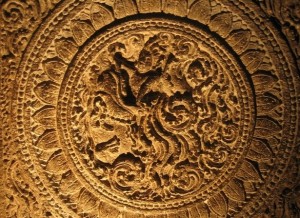 Ajanta became famous because of its remarkable paintings. They have survived only because of the remoteness and solitude of the temple complex, while the other ancient temples were destroyed by religious fanatics. But another enemy of the ancient murals have become the time and climate. As a result, only thirteen of the thirty-nine caves have preserved fragments of ancient art.
Ajanta became famous because of its remarkable paintings. They have survived only because of the remoteness and solitude of the temple complex, while the other ancient temples were destroyed by religious fanatics. But another enemy of the ancient murals have become the time and climate. As a result, only thirteen of the thirty-nine caves have preserved fragments of ancient art.
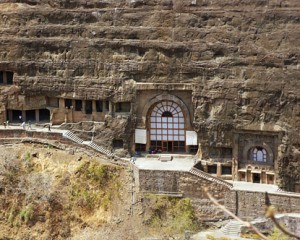 Ajanta paintings are a kind of encyclopedia of life in India for the entire historical period of V-VII centuries. Most paintings of Ajanta are the illustrations of the Buddhist legends. However, along with a strictly canonical images of the Buddha and saint bodhisattvas, there are many images that are not related to the canons. They show the scenes from the life of ancient India with amazing vigor and honesty. This is explained by the fact that the painting of the cave temples of Ajanta had a profound impact to the existing up to the present day paintings that once decorated the palaces of kings, nobles and other representatives of high society.
Ajanta paintings are a kind of encyclopedia of life in India for the entire historical period of V-VII centuries. Most paintings of Ajanta are the illustrations of the Buddhist legends. However, along with a strictly canonical images of the Buddha and saint bodhisattvas, there are many images that are not related to the canons. They show the scenes from the life of ancient India with amazing vigor and honesty. This is explained by the fact that the painting of the cave temples of Ajanta had a profound impact to the existing up to the present day paintings that once decorated the palaces of kings, nobles and other representatives of high society.
At the same time in many subjects of the Ajanta paintings there are the scenes of court life: princes are spending time in their luxury apartments, surrounded by wives and maids, or they are going to war or hunting, or taking guests. These images allow to reconstruct easily the urban architecture of India of that time. In most cases it was made of the wood: the palaces, houses of wealthy citizens, the gates, everything. Unfortunately all has been lost and nowadays we haven’t had any real samples.
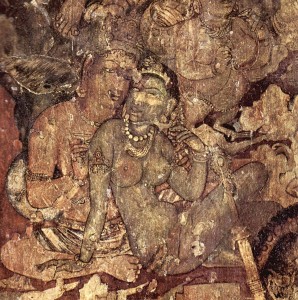
 Ajanta paintings were created over the centuries by generations of artists, so we can find their expression in many art features, trends and styles of ancient India. Volumes of these paintings are really striking: for example, in one of the underground rooms painting takes more than a thousand square meters, and it was painted not only on the walls, but on the columns and ceilings as well. And it was inside all twenty-nine caves. We have the feeling as if Indian masters were trying to move the variety and the richness of the outside world to close cave environment. They generously filled the walls and ceilings of caves by images of trees, animals and people. They were trying to fill every inch of the surface by the painting. And for over a thousand years on the walls of the dark caves there have been fussy little monkeys, bright blue peacocks, lions and fantastic fairy creature with a human torso, animal tails and bird leg. Many centuries ago they were illuminated with fire lamps and torches. Only bizarre rocks and trees know about their lives. The human world and the world of heavenly spirits, the world of Buddhist stories and the real world of “wonderful faraway India” everything all with amazing skill was embodied on the walls of cave temples of Ajanta.
Ajanta paintings were created over the centuries by generations of artists, so we can find their expression in many art features, trends and styles of ancient India. Volumes of these paintings are really striking: for example, in one of the underground rooms painting takes more than a thousand square meters, and it was painted not only on the walls, but on the columns and ceilings as well. And it was inside all twenty-nine caves. We have the feeling as if Indian masters were trying to move the variety and the richness of the outside world to close cave environment. They generously filled the walls and ceilings of caves by images of trees, animals and people. They were trying to fill every inch of the surface by the painting. And for over a thousand years on the walls of the dark caves there have been fussy little monkeys, bright blue peacocks, lions and fantastic fairy creature with a human torso, animal tails and bird leg. Many centuries ago they were illuminated with fire lamps and torches. Only bizarre rocks and trees know about their lives. The human world and the world of heavenly spirits, the world of Buddhist stories and the real world of “wonderful faraway India” everything all with amazing skill was embodied on the walls of cave temples of Ajanta.
 Along with scenes from the life of the Great Teacher – Buddha, along with images of Bodhisattvas, Buddhist monks and religious symbols in the paintings of Ajanta paintings present frankly erotic nature, from the point of view of Europeans, could hardly meet the needs of the solitary life of the monks. But this is a close co-existence of religious and erotic scenes is the traditional thing for medieval India and frankly speaking it is a common thing in almost all Buddhist and Hindu temples. Moreover, the sex scenes are often the illustrations of religious subjects from the life and teachings of Buddha. The thing which is for the Europeans looks like obscene, has never perceived in this sense by people in India, where all manifestations of human life were deemed by law. That is including those, which are taboos in other places.
Along with scenes from the life of the Great Teacher – Buddha, along with images of Bodhisattvas, Buddhist monks and religious symbols in the paintings of Ajanta paintings present frankly erotic nature, from the point of view of Europeans, could hardly meet the needs of the solitary life of the monks. But this is a close co-existence of religious and erotic scenes is the traditional thing for medieval India and frankly speaking it is a common thing in almost all Buddhist and Hindu temples. Moreover, the sex scenes are often the illustrations of religious subjects from the life and teachings of Buddha. The thing which is for the Europeans looks like obscene, has never perceived in this sense by people in India, where all manifestations of human life were deemed by law. That is including those, which are taboos in other places.
Generally the images depicted in the murals of Ajanta are not relative according to their content. The paintings represent the individual cycles, sometimes written in different times, and the relationship between these cycles is rather conventional.
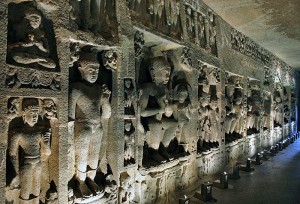 Individual episodes are depicted in the most unexpected manner with respect to each other, the different scenes are not separated by any framework, and they are mutually penetrating. And this chaotic heap of scenes only highlights the variety of the depicted events. Researchers of the murals of Ajanta always pay attention to the realism with which they have depicted life in the palaces, towns and cities in India the middle of I 000 BC, as a result of which the murals of Ajanta has taken the character of the historical document. In a scene of “Buddha is taming a wild elephant” it can be seen how the ancient commercial street in Old town looked like: shops with goods, utensils, carts, canvas awnings on bamboo poles, protecting the stall against the sun. And with astonishing skill it was depicted the elephant that frightened people and the crowds running away in panic and trying to hide. And after all probably such scene were really played out in the Indian market …
Individual episodes are depicted in the most unexpected manner with respect to each other, the different scenes are not separated by any framework, and they are mutually penetrating. And this chaotic heap of scenes only highlights the variety of the depicted events. Researchers of the murals of Ajanta always pay attention to the realism with which they have depicted life in the palaces, towns and cities in India the middle of I 000 BC, as a result of which the murals of Ajanta has taken the character of the historical document. In a scene of “Buddha is taming a wild elephant” it can be seen how the ancient commercial street in Old town looked like: shops with goods, utensils, carts, canvas awnings on bamboo poles, protecting the stall against the sun. And with astonishing skill it was depicted the elephant that frightened people and the crowds running away in panic and trying to hide. And after all probably such scene were really played out in the Indian market …
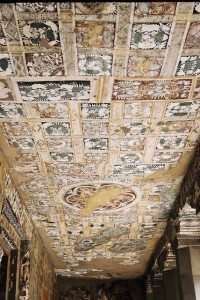 The paintings of Ajanta have naturally used the stone sculptures and reliefs. With special art it was decorated the main entrance to one of the underground churches. Above the entrance the ancient masters depicted eight figures of Buddha in pink and white clothes on a black background. Under them there are eight images of happy couples. These images have been spread all over the world and they are likely to be found in any edition devoted to the ancient Indian art. Along the both sides of the entrance inside the dim niches there are the monumental sculptures of the goddess of the sacred rivers of Gang and Yamuna. One of the goddesses is standing on a stone turtle, the other – on a crocodile. Niches with statues are surrounded by a picturesque images of dick vegetation. Ceiling paintings of Ajanta cave temples were designed to destroy the rock pressure and to lift the headroom. This is achieved by a surprising variety of ornaments that were painted on the ceilings. The ornament consists of flowers, leaves, fruits, combined with images of birds and animals. All of them were involved into the unique group. In some cases, artists tried to make the character of caisson ceiling, with ornamentation visually increasing the height of the cave arches.
The paintings of Ajanta have naturally used the stone sculptures and reliefs. With special art it was decorated the main entrance to one of the underground churches. Above the entrance the ancient masters depicted eight figures of Buddha in pink and white clothes on a black background. Under them there are eight images of happy couples. These images have been spread all over the world and they are likely to be found in any edition devoted to the ancient Indian art. Along the both sides of the entrance inside the dim niches there are the monumental sculptures of the goddess of the sacred rivers of Gang and Yamuna. One of the goddesses is standing on a stone turtle, the other – on a crocodile. Niches with statues are surrounded by a picturesque images of dick vegetation. Ceiling paintings of Ajanta cave temples were designed to destroy the rock pressure and to lift the headroom. This is achieved by a surprising variety of ornaments that were painted on the ceilings. The ornament consists of flowers, leaves, fruits, combined with images of birds and animals. All of them were involved into the unique group. In some cases, artists tried to make the character of caisson ceiling, with ornamentation visually increasing the height of the cave arches.
 Fabulously rich and varied world of Ajanta murals became known to the world only after 1819, when the long-forgotten cave temples of Ajanta were discovered by chance. In the 1920s, paintings in the caves were carefully restored and since then they have been secured. “The scenic design of the cave temples of Ajanta is in line with the best monuments of ancient Indian art and culture. Being the top of fine art of the Gupta period, the murals of Ajanta influenced the development of painting in almost all parts of medieval Asia. They were a true school for the whole generations of foreign masters. But first of all, these paintings provided a solid basis for the development of Indian traditions of fine art.
Fabulously rich and varied world of Ajanta murals became known to the world only after 1819, when the long-forgotten cave temples of Ajanta were discovered by chance. In the 1920s, paintings in the caves were carefully restored and since then they have been secured. “The scenic design of the cave temples of Ajanta is in line with the best monuments of ancient Indian art and culture. Being the top of fine art of the Gupta period, the murals of Ajanta influenced the development of painting in almost all parts of medieval Asia. They were a true school for the whole generations of foreign masters. But first of all, these paintings provided a solid basis for the development of Indian traditions of fine art.